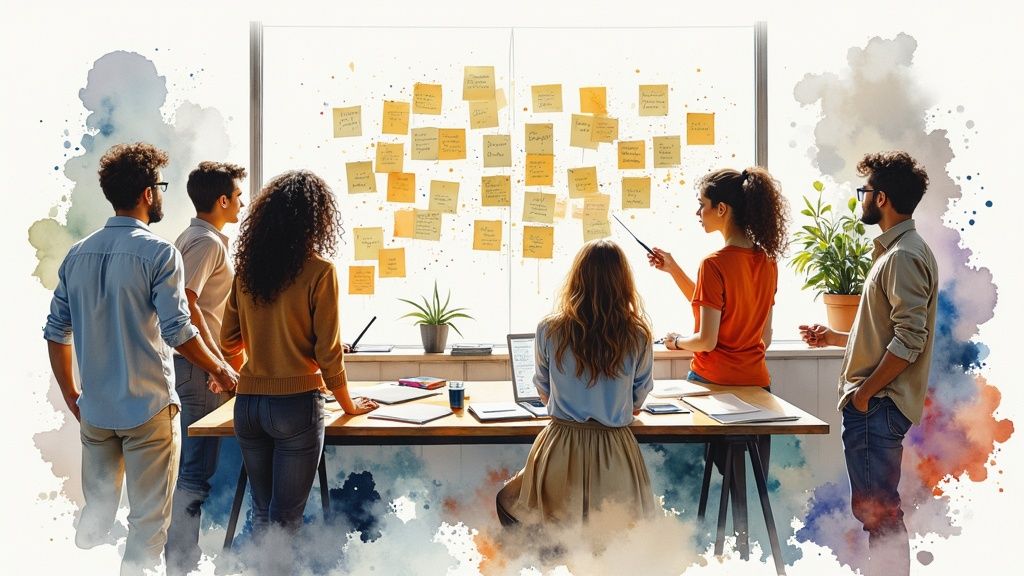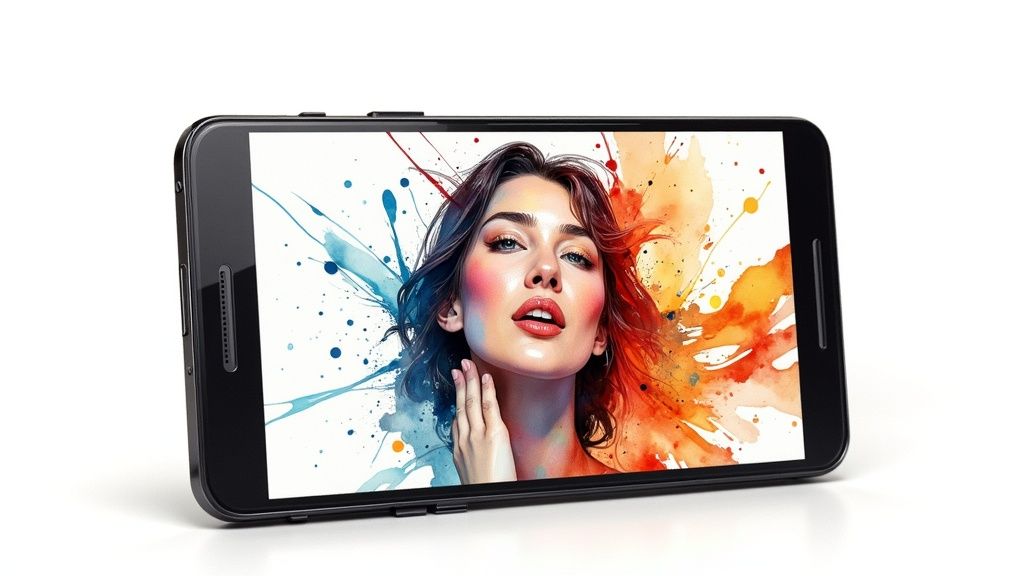Understanding the Power of Text Overlays in Modern Video Content

As video content continues to grow, viewing habits have shifted dramatically. Many people now watch videos in situations where they can't play audio - during commutes, at work, or in public spaces. This makes adding text overlays to videos not just a nice bonus, but an essential part of any effective content strategy.
The Rise of Silent Viewing
Think about how you browse social media - chances are you often scroll through your feed with the sound off. You're not alone - 85% of Facebook videos are watched without sound, according to The Complete Guide to Text Overlays for Video. Without text overlays, your video's message could miss most of your potential audience.
Accessibility and Inclusivity
Text overlays do more than just help silent viewers - they make videos accessible to everyone. For people with hearing impairments, captions and subtitles are crucial for understanding video content. Adding text also lets you translate your content into different languages, helping you reach global audiences and new markets.
Boosting Engagement and Retention
Well-placed text can make your videos more engaging and memorable. Use text to:
- Highlight key points and takeaways
- Add clear calls to action
- Provide helpful context
- Break down complex information
This approach works especially well for how-to videos, product demos, and educational content where viewers need to follow specific steps or grasp important concepts quickly.
From Passive Watching to Active Engagement
Text overlays can turn casual viewers into engaged participants. By adding interactive elements like:
- Clickable links
- Polls and quizzes
- Additional resources
- Step-by-step guides
You create opportunities for viewers to interact directly with your content. For instance, a cooking video could include clickable links to recipes and ingredient lists, making it easier for viewers to take action while watching.
Measuring Success: ROI and Performance Metrics

Making engaging videos with text overlays is only part of the equation. The other crucial piece is measuring how well they perform. This means going deeper than basic view counts to examine meaningful data like Return on Investment (ROI) and specific performance indicators.
Key Performance Indicators (KPIs) for Videos With Text Overlay
To properly assess how your video overlays are doing, focus on these key metrics:
- Viewer Retention Rate: Shows how long people watch your video. Higher rates mean your content and text overlays are keeping viewers interested.
- Click-Through Rate (CTR): Measures how often viewers click on your calls-to-action. This directly shows if your overlays drive the desired actions.
- Conversion Rate: Tracks whether viewers complete your goals like making purchases, submitting leads, or signing up for newsletters.
- Engagement Rate: Includes likes, shares, and comments. Strong engagement suggests your content connects with your target viewers.
- Play Rate: Shows what percentage of people start your video after seeing the preview. High rates mean your preview text draws people in effectively.
Looking at these numbers helps content creators make smarter decisions. For instance, checking retention rates reveals exactly where viewers stop watching, pointing to specific spots where the video or text could be better. Tracking conversions connects your overlay efforts directly to real business results.
A/B Testing: Fine-Tuning Your Overlay Strategy
A/B testing offers a clear path to better results. Create two versions of your video with small differences in the overlay text - maybe changing colors, fonts, placement or wording. By comparing how each version performs, you'll see which choices work best. This practical approach takes the guesswork out of overlay design. Learn more about optimizing text overlays here. Research shows videos using text overlays get 28% longer view times and deliver 1.8 times better ROI than those without.
Data-Driven Optimization: The Path to Continuous Improvement
Top brands regularly check their data to understand what connects with viewers. They monitor how overlay changes affect their key metrics. This ongoing process of testing and refining helps maintain steady performance gains. Using analytics tools gives you clear insights into viewer behavior so you can keep improving your approach.
Best Practices for Text Overlay Design
Adding text to videos requires careful thought and planning. When done right, text overlays help viewers better understand and engage with your content. Let's explore the key elements that make text overlays work.
Typography and Readability
Pick fonts that are easy to read and match your brand's style. Skip fancy decorative fonts that become hard to decipher, especially on phones and small screens. Make text large enough to read comfortably across all devices. Want to learn more? Check out our guide on how to superimpose text on video.
Color and Contrast
The colors you choose affect how viewers feel about and interact with your content. Pick colors that fit your brand while ensuring text stays readable. The key is strong contrast between text and background. White text on dark backgrounds (or vice versa) usually works well. Adding subtle shadows or outlines can help text stand out against busy video scenes.
Placement and Timing
Put text where it won't block important video elements. The bottom third of the screen often works best since it's usually free of key action. Give viewers enough time to read comfortably - but not so long that text becomes a distraction. Match text timing to your video's pace and message complexity.
Hierarchy and Emphasis
Help viewers quickly grasp key points through smart text formatting. Use bold text or bigger fonts to highlight main ideas. Try different text sizes or colors to show what's most important. For example, make titles larger than supporting details.
Testing and Accessibility
Before publishing, view your video on different screens to check text readability. Make sure everyone can access your content by adding closed captions for deaf or hard-of-hearing viewers. Include alt text descriptions so screen readers can convey text overlays to visually impaired users.
Tools and Technologies for Professional Overlay Creation
Video with text overlay needs the right tools. Finding the right video editing tools for your goals and budget requires understanding the key options available today.
Software Solutions: From Basic to Advanced
Here's a clear breakdown of video editing software based on your skill level and project needs:
-
Beginners can get started with mobile apps like iMovie for iOS and InShot for Android/iOS. They include basic text effects and pre-made templates - perfect for quick social media videos.
-
Intermediate users will benefit from software like Filmora and Camtasia. These tools offer more control with features like text animation and keyframing, while staying easy to use. They work well for marketing videos and tutorials.
-
Professional editors typically use industry standards like Adobe Premiere Pro and Final Cut Pro. These give you complete control over every aspect of text and motion graphics but require more time to master.
Want to improve your social media videos? Check out our guide: How to master video editing for social media.
AI Tools Make Text Overlay Easier
AI video tools help speed up common text overlay tasks:
- Quick Subtitles: AI can transcribe your video and create accurate captions automatically
- Text-Based Editing: Edit your video by changing the transcript text - the video adjusts automatically
- Content Conversion: Turn written content like blog posts into videos with text overlays
These AI features help you create more videos in less time while maintaining quality.
Create an Efficient Production Process
No matter which tools you use, good workflow habits make a big difference:
- Plan Your Text: Write your script first and mark where text overlays will help explain key points
- Keep Files Organized: Store all your videos, fonts and graphics in one easy-to-find place
- Use Ready-Made Templates: Save time with pre-designed templates that match your brand
- Test Different Approaches: Try various text styles and placements to see what works best. Testing helps you improve results over time.
A smooth workflow combined with the right AI tools lets you create professional text overlays faster. This gives you more time to focus on making content that connects with your viewers.
Platform-Specific Strategies for Maximum Impact

Each social media platform has its own unique requirements for video with text overlay. Simply copying the same approach across platforms won't give you the best results. Let's explore how to get the most out of text overlays on the major social platforms.
Instagram: Visually Driven Storytelling
On Instagram, users scroll quickly through their feeds, making clear and concise text essential.
- Keep text brief: Use short phrases that make an immediate impact
- Balance with visuals: Text should enhance, not compete with, your video
- Match your brand: Pick fonts and colors that fit your visual identity
- Adapt for format: Stories need faster-paced text than Feed posts
For instance, a clothing brand might use quick text callouts in Stories to highlight product features, while using longer text in Feed posts to share their brand message.
TikTok: Quick and Creative
TikTok users expect short, creative videos that tap into current trends.
- Follow trends: Use popular sounds and hashtags with your text
- Show personality: Add fun, conversational text that fits TikTok's style
- Add movement: Try TikTok's text animation tools to grab attention
- Join conversations: Use text to respond to comments and participate in trends
Success on TikTok often comes from staying current with trends and using text that connects with the platform's style.
YouTube: Detailed Content Enhanced by Text
YouTube's longer format lets you use text in more varied ways.
- Add value: Use text to explain concepts or provide extra details
- Guide actions: Add clear prompts to subscribe, like, or visit your site
- Include captions: Make content accessible with proper subtitling
- Mark sections: Use text to highlight key points in longer videos
Text can also help with YouTube search rankings by including relevant keywords. For more tips, check out social media video best practices.
LinkedIn: Professional and Clear
LinkedIn content needs to maintain a business-appropriate tone.
- Share facts: Highlight key statistics and research findings
- Build credibility: Display professional qualifications and expertise
- Stay professional: Use clear, business-appropriate language
- Deliver value: Offer useful tips and insights through text
A business consultant, for example, might use text to highlight key findings from industry research or outline their services with a clear call-to-action. By understanding each platform's specific needs, you can create more effective video content with text that truly connects with your audience.
Advanced Techniques and Future Innovations

Video text overlays continue to grow in new and exciting ways. Fresh approaches and tools open up creative possibilities for making video content more impactful and meaningful for viewers.
Interactive Captions and Motion Typography
Interactive captions let viewers click text elements to access additional information and context. A history documentary could use this to provide background on key historical figures or events mentioned in the video.
Motion typography brings text to life through animation and movement across the screen. Product demos and brand videos can use dynamic text transitions to highlight key features and grab attention at crucial moments.
AI-Powered Solutions
AI technology has made adding text to videos faster and more efficient. Features like automated transcription and translation help creators quickly add captions in multiple languages. AI can suggest ideal text placement and timing to maximize readability and impact, letting creators focus more on storytelling.
The Future of Video Text Overlays
Several developments are set to change how we use text in videos. Automated translation will help videos reach viewers worldwide by breaking down language barriers. Responsive design ensures text displays properly across devices - from phones to large screens.
Here's what's coming next:
- Personalized Text: AI could customize text based on who's watching, creating more relevant messaging
- Augmented Reality Text: Text that interacts with real-world elements through AR for an immersive experience
- Live Text Interaction: Adding interactive text elements to live streams for polls and Q&As
Understanding these trends helps prepare for the evolving world of video content creation.
Want to take your video content to the next level? Aeon makes it simple to create professional videos with text overlays using AI. Their platform helps publishers automate production, customize voices, and optimize for social sharing.